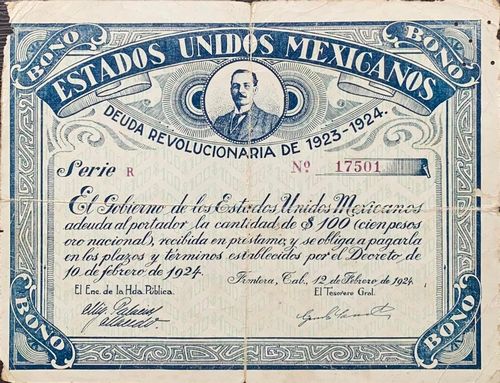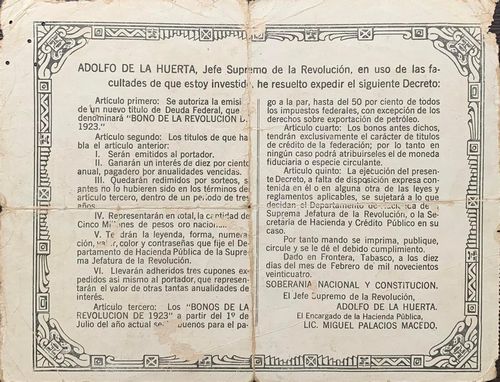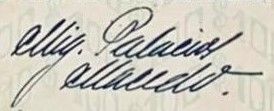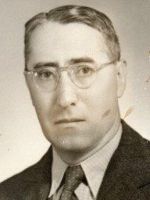Adolfo de la Huerta
As Governor of the northern state of Sonora, Adolfo de la Huerta led the Revolution of Agua Prieta, which put an end to the presidency of Venustiano Carranza, who was killed during the revolt. It was then that de la Huerta was appointed interim President by Congress. When Alvaro Obregón was declared the victor of the 1920 presidential election, de la Huerta stepped down and became the Secretario de Hacienda y Crédito Público.
In 1923, when Obregón endorsed Calles as his successor, de la Huerta started a revolt. He won the support of Catholics, conservatives and a considerable portion of the army officers but with his superb organizing ability and popular support, Obregón crushed the rebellion and forced de la Huerta into exile.
As the rebellion progressed, Tabasco, due to its geographical isolation, became the safest stronghold for the rebels. Adolfo de la Huerta left Veracruz on 5 February 1924, establishing his government in the port of Frontera, which on 20 February he declared the "delahuertista Capital of Mexico". However, on 7 March 1924, de la Huerta fled to Los Angeles and Obregón ordered the execution of every rebel officer with a rank higher than a major.
Potential note issue
In December 1923 the firm Vickers, representing some Mexican agency, approached the London office of Bradbury, Wilkinson & Company, an ABNC subsidiaryThe original company was established in the 1850s by Henry Bradbury and begin printing banknotes in 1856. Bradbury then died in 1860. In 1873–74 the firm built an imposing six-storey workshop, for engraving printing plates, in Holborn, London at 25 and 27 Farringdon Road. In 1903 the company was acquired by the American Bank Note Company. In 1917 it moved to New Malden in Surrey still operating as Bradbury-Wilkinson as a wholly owned subsidiary of ABNC., for a quote for twelve million notes in nine denominations. When informed, the New York office tried to get their agent in Mexico City to find out who was placing the order, and he replied that the enquiry was not from the government or any bank and suggested that it must be coming from Adolfo de la Huerta, in Veracruz. The ABNC replied to their Mexican agent that “they would not offer to make bank notes for any unrecognized government party”ABNC.
Bond issue
On 10 February 1924, while at Frontera, Tabasco, in an attempt to finance his revolt de la Huerta authorised an issue of Bonos de la Revolución de 1923. There was to be $5m, carrying an interest of 5%, acceptable in payment for up to 50% of federal taxes, and redeemable within three years. Though they were al portador, they were not to be considered as money or legal tender.
We know of one example, a series R for $100, dated 12 February 1924.

 M4461 $100 Deuda Revolucionaria
M4461 $100 Deuda Revolucionaria
| series | from | to | total number |
total value |
||
| $100 | R | includes number 17501 |
These carry the signatures of Miguel Palacios Macedo as Encargado de la Hacienda Pública and [ ][identification needed] as Tesorero General.
|
Miguel gained a law decree at the Escuela Nacional de Jurisprudencia and was professor of American history at the Free Preparatory School in 1917. In 1920 the government of interim president Adolfo de la Huerta appointed him to the Board of Surveillance and Prisons. The following year, when Alvaro Obregón became president, de la Huerta was appointed Secretaría de Hacienda y Crédito Público. He commissioned Manuel Gómez Morín to review banking and fiscal policies and Gómez Morín created a seminar on fiscal studies to study how to provide states and municipalities with their own finances, which Palacios Macedo headed. In 1921 Mexico celebrated the centenary of full independence, and to finance the celebrations, de la Huerta commissioned Gómez Morín to make a law that would allow him to create an additional tax. He in turn commissioned Palacios Macedo to write the law in one night, which was enacted without amendments. He also participated in the drafting of the Ley de Liquidación de los Antiguos Bancos de Emisión. In 1922, Palacios Macedo accompanied de la Huera to New York to sign the de la Huerta-Lamont agreement on the payment of the Mexican public debt. Palacios Macedo remain loyal to de la Huerta and, when the latter rebelled, was treasury secretary to his movement, thus signing these bonds. In 1924, after the revolt failed, he took exile in France where he studied economics and philosophy at the Sorbonne and at the Free School of Political Science in Paris. He returned to Mexico in 1929 and, parallel to his professional activities, began a long academic career. He was one of the founders of the Banking and Commercial School, where he taught, among others, the subjects Currency, Credit and Higher Economic Theory. He was also a professor at the Autonomous Technological Institute of Mexico (ITAM), where he taught the Introduction to Economics class. Commissioned by Alberto Mascareñas Navarro, managing director of the Banco de México, he founded and directed the magazine Economía, which was sponsored by the Asociación de Banqueros. He was the main advisor to Luis Montes de Oca, general director of the Banco de México (1935-1940) and, subsequently, a director of the Banco de Londres y México. He was a contributor to several newspapers, in particular the newspaper El Universal, where in 1943 he wrote an article on political corruption that made him famousEl Universal, . He died in Mexico City on 16 November 1990. |
 |
 |
As de la Huerta's revolt failed, any bond (if any) issued in the short period between 12 February and the final defeat in June 1924 will have been rended worthless (and possibly too dangerous to hold on to).

 Miguel Palacios Macedo was born in Tulancingo, Hidalgo, on 7 September 1898. His grand-father was Colonel Miguel Palacios, in charge of the Emperor Maximilian’s execution, and his father was General José María Palacios, chief of the medical service of Villa’s División del Norte.
Miguel Palacios Macedo was born in Tulancingo, Hidalgo, on 7 September 1898. His grand-father was Colonel Miguel Palacios, in charge of the Emperor Maximilian’s execution, and his father was General José María Palacios, chief of the medical service of Villa’s División del Norte.